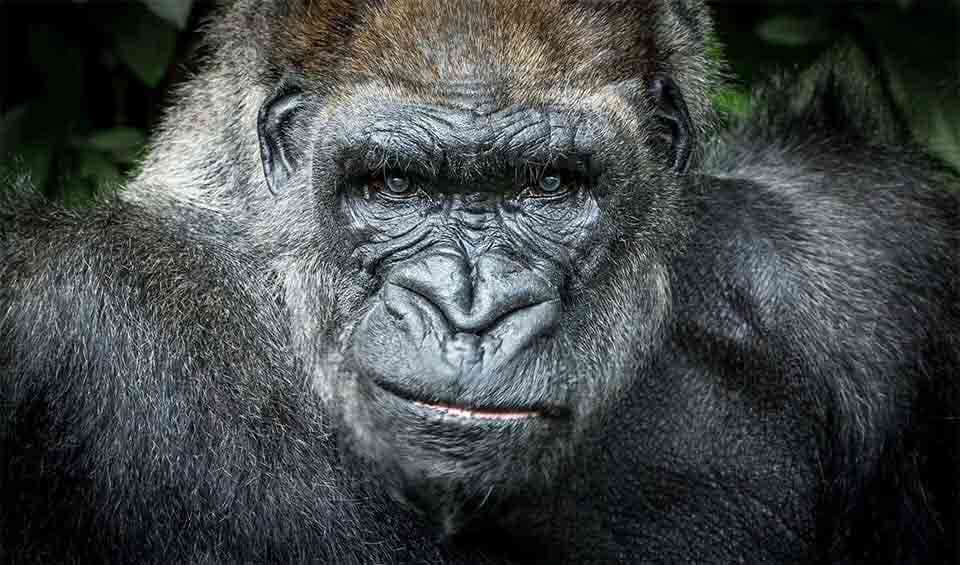Distinguished by their robust build and a coat of brownish-black fur, they lack tails, setting them apart in the primate world. Their facial features, characterized by a pronounced brow ridge, a distinct nose resembling a squashed tomato, flared nostrils, and comparatively smaller ears, add to their unique physical appearance, distinguishing them from their eastern counterparts and other primates.
The social structure of western gorillas is both intricate and cohesive, centered around a dominant male known as the “silverback” due to the distinctive silver sheen of fur on his back, a sign of maturity and leadership. The silverback leads a group comprising several adult females and their offspring, fostering an environment of stability and cooperation within the group. Despite their formidable strength and capability for intimidation—often demonstrated by impressive chest-beating to deter potential threats or rival males—western gorillas are fundamentally peaceful and shy creatures, preferring to avoid conflict whenever possible.
Their diets favor a variety of plant-based foods. Their meals consist of juicy stemmed plants, fruits, berries, leaves, and bark, reflecting their role as vital agents in their ecosystems. Through their feeding habits, they contribute to seed dispersal and the maintenance of healthy, biodiverse forests. However, their reliance on specific foods also makes them vulnerable to changes in their environment that affect food availability.
The challenges facing western gorillas in today’s world are manifold. Poaching remains a pervasive threat, fueled by demand for bushmeat and illegal wildlife trade, while infectious diseases pose a significant risk to their populations. Habitat degradation and destruction, driven by deforestation for agricultural expansion, mining, and infrastructure development, fragment their living spaces, severely impacting their ability to thrive. Furthermore, climate change introduces additional stressors, altering the ecosystems they depend on and potentially disrupting their food sources.
Distribution
 Angola
Angola Official estimate
Official estimate
 Cameroon
Cameroon Central Af. Rep.
Central Af. Rep. Congo-Brazzaville
Congo-Brazzaville Official estimate
Official estimate
 Equatorial Guinea
Equatorial Guinea Official estimate
Official estimate
 Gabon
Gabon Official estimate
Official estimate
 Nigeria
NigeriaRecent updates
Feb 2022: The government of Cameroon announced plans to create a new national park to protect Western lowland gorillas and other wildlife. The park will cover an area of 6,600 km² (660,000 hectares) and be located in the southwest of the country.
Dec 2021: The Zoological Society of London (ZSL) released a report warning that Western gorillas could be extinct in the wild within the next 25 years if urgent action is not taken to protect them. The report called for increased protection of gorilla habitat and a crackdown on the illegal wildlife trade.
Did you know?
- The Ebola virus caused an estimated decline of 45% for 20 years (1992 – 2011) in protected areas. Major concerns that it might be depleting the population to the point of no-return.
- Males are larger and weigh almost double of females.
- More than 60 percent of the population has gone in over the last two decades.
- 80% of the Gorillas live outside the protected areas.
- Infants have a distinct white patch on their rump that helps in identification by moms.
- Gorilla kids have massive demand in the pet market. For this illegal trade, around 10-20 adult gorillas are killed to kidnap every single baby. Gorillas are very protective of their young and defend them at any cost.
Anything we've missed?
Help us improve this page by suggesting edits. Glory never dies!
Suggest an editGet to know me
Terrestrial / Aquatic
Altricial / Precocial
Polygamous / Monogamous
Dimorphic (size) / Monomorphic
Active: Diurnal / Nocturnal
Social behavior: Solitary / Pack / Herd
Diet: Carnivore / Herbivore / Omnivore / Piscivorous / Insectivore
Migratory: Yes / No
Domesticated: Yes / No
Dangerous: Yes / No




